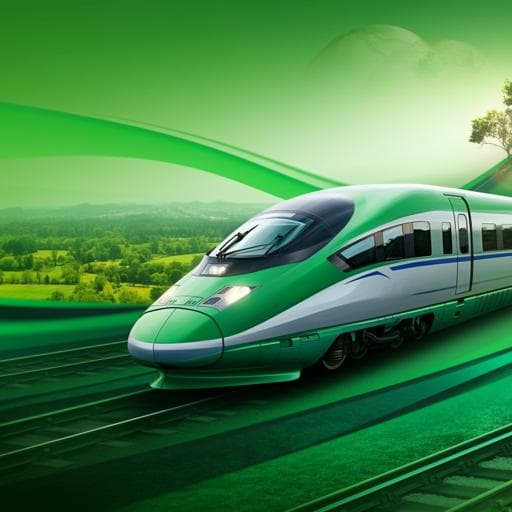
Transportation
High-speed railways reduces carbon emissions: mediating effects of green innovation and the resilience of environmental investment
H. Wang, T. Zhang, et al.
This study reveals how high-speed rail (HSR) in China can effectively reduce carbon emissions by promoting green innovation and enhancing the resilience of environmental investment. Conducted by Hao Wang, Tao Zhang, and Xi Wang, this research provides significant insights into the interplay between transportation and environmental sustainability.
~3 min • Beginner • English
Introduction
With economic and social advancements, inaugurating HSRs is gaining academic attention as a public policy. Some scholars argue HSRs were introduced to accelerate interregional exchanges (economy, resources, culture, people). Evidence from places such as California and Florida notes construction and operation can consume large energy and raise emissions, while other studies suggest reductions are feasible with sustainable plans. International evidence (Japan’s Shinkansen, Germany, UK) points to contributions to resilience, sustainability, and reduced emissions, though effects vary by spatial context. In China, HSR aims to promote regional development, mobility, and growth. China’s network is the world’s largest and fastest, with domestically innovated technologies and strong state support. This study investigates whether HSR introduction reduces urban carbon emissions in China and explores mechanisms, focusing on green innovation (GI) and resilience of environmental investment (REI). Prior research indicates HSR improves resource and information transfer efficiency, openness, and environmental friendliness, potentially reducing emissions. HSR is defined by high speed, efficiency, density, and emphasis on safety and environmental protection, contributing to intercity integration and sustainable transport. China’s HSR expansion since 2007 has been rapid. Literature shows mixed social and environmental impacts. GI involves ecofriendly innovation across clean energy, renewables, green production/consumption, and climate technologies, important for sustainability and public health. REI is defined as the capacity of environmentally related investments to remain effective amid environmental pressures and shocks, improving cities’ ability to avoid additional emissions through adaptation, risk management, and pursuit of low-carbon opportunities. Carbon emissions (CO2) arise primarily from fossil fuel combustion and are a major driver of climate change; city-level measurements are used. From a sustainable transportation perspective, HSR can elevate GI and influence REI. However, whether GI and REI mediate the HSR–emissions link remains underexplored. This study fills that gap by proposing that HSR enhances information flows and technology diffusion, thereby elevating GI and REI, which in turn reduce emissions. We also consider boundary conditions: digital economy development, urban–rural disparities, and resource-based city status.
Literature Review
The literature offers mixed findings on HSR’s environmental impacts. U.S. cases (California, Florida) highlight the potential for increased energy use unless sustainable operations are adopted, while studies from Japan and Germany report contributions to resilience and lower urban emissions. In the UK, benefits are spatially heterogeneous along corridors. Within China, HSR has been associated with improved regional development, resource flow and information efficiency, and environmental outcomes, but concerns persist about energy use and pollution during construction/operation. Green innovation (GI) literature emphasizes clean energy, renewable resources, low-carbon production/consumption, and climate technologies as central to sustainable development and public health. Studies on resilience indicate that resilient systems can adapt and maintain function under shocks; applying this to environmental investment (REI) suggests that cities with stable and flexible environmental investment systems can better manage risks, reduce failure rates, and avoid excess emissions. Theoretical perspectives used to frame HSR impacts include signaling theory (HSR enhances information flow and transparency, mitigating information asymmetries), stakeholder theory (improving coordination among government, firms, passengers, and communities), resource-based theory (GI and REI raise resource-use efficiency), fault tolerance theory (REI enhances system stability under shocks), and social inclusion theory (HSR-facilitated GI/REI foster environmentally friendly, inclusive communities). Taken together, prior research implies that HSR may reduce emissions directly and indirectly via GI and REI, but the mediating roles have not been empirically established across Chinese cities, motivating the present study.
Methodology
Sample: Panel data for 284 Chinese prefecture-level cities from 2000–2021. All continuous variables are winsorized at the 1% and 99% levels. The authors report a final sample of 4920 observations; main regression tables often report N≈5163, reflecting available observations across variables.
Design: Difference-in-differences (DID) with city and year fixed effects to estimate impacts of HSR openings. Baseline model: CO2_it = β0 + β1 DID_it + Σ Controls_it + Year_FE + City_FE + μ_t + ε_it.
Key variables:
- Treatment (HSR introduction, DID): Indicator equals 1 for a city-year from the year after its HSR opening onward; 0 otherwise.
- Mediators:
• Green innovation (InGI): Number of city-level environmental protection-related patents granted. Robustness: green R&D expenditure efficiency (Gtecheff) and green outcome transformation efficiency (Gtraneff).
• Resilience of environmental investment (REI): Measured via EI stability (InEIS) and EI flexibility (InEIF). Environmental investment efficiency is first computed using an SBM-DEA model with inputs (environmental investment intensity; fiscal environmental protection expenditure share), desirable outputs (environmental funds’ market value share; environmental liability insurance revenue share), and undesirable outputs (SO2 and industrial wastewater emission rates). REI components: Stability is the maximum proportional loss in environmental investment efficiency during the 2008 financial crisis (reverse-coded); Flexibility is the recovery time from the efficiency trough to 30% of the 2008 efficiency level (reverse-coded).
- Outcome (InCO2): Log of CO2 emissions from the China City Statistical Yearbook. Robustness: economic performance of emissions (InCEE), social performance (InCSE), SO2 emissions and SO2 treatment metrics.
Controls: Population (Inpeo), green area (Ingreenarea), hospitals (Inhos), telecom revenue (Ininfor), industrial output (Inindu), employment in mining (Inmine) and manufacturing (Inmanu), household LPG use (InLPG), city natural gas supply (Ingas), electricity consumption (Inelec).
Moderators:
- Digital economy (Digitalcity/InDigital, DID_Digitalcity): Composite index (entropy method) using information/ICT indicators; also a DID based on National Big Data Comprehensive Pilot Zones.
- Urban–rural disparity (InU-Rdiff/HDI gap): Thiel index and urban–rural HDI gap.
- Resource-based city (Resourcecity, DID_Resourcecity): Indicator (=1 if resource-based) and a DID exploiting the 2014 Environmental Protection Law as a quasi-experiment.
Estimation and validation:
- Baseline DID with two-way fixed effects.
- Parallel trends tests for CO2, GI, InEIF, InEIS (event-study style), visualized and tabulated.
- Propensity score matching combined with DID (PSM-DID) with year-by-year matching to address selection bias.
- Placebo tests: Randomize treatment assignment and timing; repeat 200 times; coefficients cluster around zero with high p-values, supporting robustness.
- Instrumental variables FE approach for HSR endogeneity: Instruments are nighttime lighting index and terrain relief (reverse-coded); both correlate with HSR but plausibly exogenous to CO2.
- Heterogeneity analyses: By population size, city area, GDP, public finance size, and water resources.
- Robustness with alternative measures: HSR use (number of stops, HSR line density), alternative mediators and moderators; results remain consistent.
Key Findings
- Baseline effect: DID coefficient on InCO2 is significantly negative, indicating HSR openings reduce carbon emissions (verifies Hypothesis 1).
- Mediation via GI and REI: In models including mediators, coefficients on InGI (-0.369), InEIF (-0.695), and InEIS (-0.084) are significantly negative, supporting partial mediation (Hypotheses 2, 3a, 3b). HSR increases GI and REI (positive DID effects on mediators), which in turn reduce CO2.
- Elasticities (directional summary): DID→CO2: -0.001; DID→InGI: +0.125; InGI→CO2: reduction of 0.094 per unit elasticity; DID→InEIF: +0.023; InEIF→CO2: -0.108; DID→InEIS: +0.159; InEIS→CO2: -0.001. The direct HSR-induced reduction in CO2 is statistically significant but modest in magnitude; indirect effects via GI and REI are material.
- Moderation by digital economy: Digital economy strengthens the HSR→GI and HSR→REI links and amplifies the negative HSR→CO2 effect (Hypotheses 4a–4d supported).
- Moderation by urban–rural disparity: A larger urban–rural gap weakens HSR’s emissions-reducing effect (Hypothesis 5 supported).
- Moderation by resource-based status: In resource-based cities, the emissions-reduction effect is weakened and can reverse (HSR associated with higher emissions), supporting Hypothesis 6.
- Robustness: Parallel trends satisfied; PSM-DID confirms signs and significance; placebo tests show randomized treatments yield null effects; IV results uphold causality; alternative operationalizations (emissions benefits, HSR usage intensity, alternative GI/REI measures) preserve conclusions.
- Heterogeneity: Emissions reductions from HSR stronger in larger-population, larger-area, and higher-GDP cities; some mediating components (e.g., EI stability) can be insignificant in certain strata. Results overall align with main findings.
Discussion
Findings support the central hypothesis that HSR openings reduce urban carbon emissions both directly and indirectly through increased green innovation and enhanced resilience of environmental investment. The direct effect aligns with signaling and stakeholder theories: HSR improves information flows, lowers coordination and agency costs, and facilitates environmentally oriented governance and investment. Indirectly, HSR catalyzes technology diffusion and investment risk management, elevating GI and REI, which improve resource-use efficiency and lower emissions, consistent with resource-based and fault tolerance perspectives. The digital economy context strengthens these pathways by further reducing information frictions and boosting innovation diffusion, while structural inequalities (urban–rural disparities) and reliance on extractive industries (resource-based cities) constrain or reverse benefits. These results clarify the mechanisms linking transport infrastructure to environmental outcomes and indicate where complementary policies are necessary to realize emission reductions.
Conclusion
This study shows that opening high-speed rail reduces city-level carbon emissions in China and that green innovation and the resilience of environmental investment (stability and flexibility) are key mediating mechanisms. The digital economy strengthens HSR’s positive impacts on GI/REI and emissions reduction, whereas urban–rural disparities and resource-based city status weaken them, with resource-based cities sometimes experiencing increased emissions post-HSR. Contributions include: (1) establishing GI and REI as mediating channels in the HSR–emissions relationship, enriching signaling, agency, stakeholder, resource-based, fault tolerance, and social inclusion perspectives; (2) operationalizing REI via SBM-DEA-based stability and flexibility metrics; (3) identifying boundary conditions via digital economy development, urban–rural gaps, and resource dependence. Future research should diversify data sources (beyond yearbooks), incorporate primary data (surveys, interviews, case studies), and extend comparative analyses to other countries to generalize findings.
Limitations
- Data source concentration: Reliance on the China City Statistical Yearbook may not capture all relevant realities across indicators.
- Sample heterogeneity: Broad scope requires deeper assessment of heterogeneity; some models exhibit low R-squared, indicating room for improved specifications.
- Generalizability: Focus on Chinese cities may entail sample selection bias; cross-country comparisons are needed for external validity.
- Measurement constraints: Despite robustness checks, certain mediators/moderators and alternative emissions metrics may still omit contextual nuances.
Related Publications
Explore these studies to deepen your understanding of the subject.







